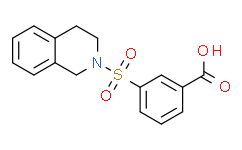| DC60781 |
TRPC6 activator compound 2
|
TRPC6 activator compound 2 is selective activator of TRPC6 that does not potentiate TRPC3 and mTRPC7. Comp2 is able to cross BBB. |
| DC66546 |
R-Sirpiglenastat
|
R-Sirpiglenastat is the R- isomer of Sirpiglenastat(DRP-104).Sirpiglenastat (DRP104) is a broad acting glutamine antagonist. Sirpiglenastat has anticancer effects by directly targeting tumor metabolism and simultaneously inducing a potent antitumor immune response. |
| DC60597 |
AZD0780
|
AZD0780 is the first oral small molecule PCSK9 inhibitor for the treatment of hypercholesterolemia. |
| DC90056 |
PLX-5622 HCl form (water solubility form)
|
PLX5622 is the HCl salt form of PLX-5622, which has better water solubility.PLX-5622 is a highly selective brain-penetrant CSF1R inhibitor (IC50=0.016 µM; Ki=5.9 nM) allowing for extended and specific microglial elimination, preceding and during pathology development. |
| DC60559 |
PT-179
|
PT-179 is a new orthogonal immunomodulatory drug (IMiD) derivative that binds CRBN but does not induce degradation of off-target proteins. PT-179 potently degrades proteins fused to SD40 at either the N or C terminus. |
| DC65830 |
1-M-PES(1-Methoxy-5-methylphenazinium ethyl sulfate)
|
1-m-PES is an electron mediator which has higher stability of solutions than 1-Methoxy PMS. The stability in neutral to alkali conditions has been extremely improved with 1-Methoxy PES. 1-M-PES is a stable small-molecular compound and it has an equal or higher thermal stability than diaphorase. The 1-Methoxy PES solution can be stored long term. |
| DC65821 |
Upadacitinib hemihydrate
|
Upadacitinib (ABT-494) is a potent and selective Janus kinase (JAK) 1 inhibitor with an IC50 of 43 nM, being developed for the treatment of several autoimmune disorders. |
| DC65697 |
HDAC6 inhibitor 4510
|
A novel and seletive HDAC6 inhibitor. |
| DC65676 |
Fenretinide Glucuronide Monosodium Salt
|
Fenretinide Glucuronide Monosodium Salt, is the metabolite of Fenretinide (F250000), which is a synthetic retinoid deriverative, substances related to vitamin A. They are also shown to be used for the treatment of cancer, as well as in the treatment of cystic fibrosis, rheumatoid arthritis, acne, and psoriasis. |
| DC60500 |
NVS-STG2
|
NVS-STG2 is a molecular glue that targets STING and activates STING-mediated immune signaling. NVS-STG2 induces higher-order oligomerization of human STING by binding to pockets between adjacent STING dimer transmembrane domains, effectively acting as a molecular glue. NVS-STGI enhances the activity of cGAMP by inducing the formation of more abundant and larger oligomers. NVS-STG2 produces antitumor activity in animal models. |






















